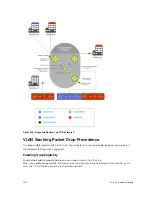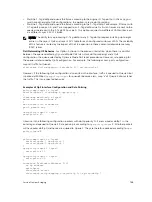
45
sFlow
Configuring sFlow is supported on Dell Networking OS.
Overview
The Dell Networking Operating System (OS) supports sFlow version 5.
sFlow is a standard-based sampling technology embedded within switches and routers which is used to
monitor network traffic. It is designed to provide traffic monitoring for high-speed networks with many
switches and routers. sFlow uses two types of sampling:
• Statistical packet-based sampling of switched or routed packet flows.
• Time-based sampling of interface counters.
The sFlow monitoring system consists of an sFlow agent (embedded in the switch/router) and an sFlow
collector. The sFlow agent resides anywhere within the path of the packet and combines the flow
samples and interface counters into sFlow datagrams and forwards them to the sFlow collector at regular
intervals. The datagrams consist of information on, but not limited to, packet header, ingress and egress
interfaces, sampling parameters, and interface counters.
Application-specific integrated circuits (ASICs) typically complete packet sampling. sFlow collector
analyses the sFlow datagrams received from different devices and produces a network-wide view of
traffic flows.
Implementation Information
Dell Networking sFlow is designed so that the hardware sampling rate is per line card port-pipe and is
decided based on all the ports in that port-pipe.
If you do not enable sFlow on any port specifically, the global sampling rate is downloaded to that port
and is to calculate the port-pipe’s lowest sampling rate. This design supports the possibility that sFlow
might be configured on that port in the future. Back-off is triggered based on the port-pipe’s hardware
sampling rate.
The default global sampling rate is 32768. The sampling rates are determined as follows:
• If the interface states are up and the sampling rate is not configured on the port, the default sampling
rate is calculated based on the line speed.
• If the interface states are shut down, the sampling rate is set using the global sampling rate.
• If the global sampling rate is non-default, for example 256, and if the sampling rate is not configured
on the interface, the sampling rate of the interface is the global non-default sampling rate, that is, 256.
To avoid the back-off, either increase the global sampling rate or configure all the line card ports with the
desired sampling rate even if some ports have no sFlow configured.
sFlow
771
Содержание Z9000
Страница 1: ...Dell Configuration Guide for the Z9000 System 9 7 0 0 ...
Страница 80: ...grub reboot 80 Management ...
Страница 128: ... 0 Te 1 1 Te 1 2 rx Flow N A N A 128 Access Control Lists ACLs ...
Страница 436: ...Figure 50 Inspecting Configuration of LAG 10 on ALPHA 436 Link Aggregation Control Protocol LACP ...
Страница 439: ...Figure 52 Inspecting a LAG Port on BRAVO Using the show interface Command Link Aggregation Control Protocol LACP 439 ...
Страница 440: ...Figure 53 Inspecting LAG 10 Using the show interfaces port channel Command 440 Link Aggregation Control Protocol LACP ...
Страница 491: ...Figure 70 Configuring OSPF and BGP for MSDP Multicast Source Discovery Protocol MSDP 491 ...
Страница 492: ...Figure 71 Configuring PIM in Multiple Routing Domains 492 Multicast Source Discovery Protocol MSDP ...
Страница 496: ...Figure 73 MSDP Default Peer Scenario 1 496 Multicast Source Discovery Protocol MSDP ...
Страница 497: ...Figure 74 MSDP Default Peer Scenario 2 Multicast Source Discovery Protocol MSDP 497 ...
Страница 498: ...Figure 75 MSDP Default Peer Scenario 3 498 Multicast Source Discovery Protocol MSDP ...
Страница 760: ...Figure 100 Single and Double Tag TPID Match 760 Service Provider Bridging ...
Страница 761: ...Figure 101 Single and Double Tag First byte TPID Match Service Provider Bridging 761 ...






























